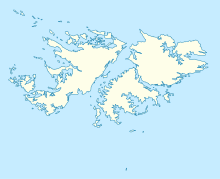Bluff Cove Disaster
| Bluff Cove Air Attacks | |||||||
|---|---|---|---|---|---|---|---|
| Part of Falklands War | |||||||
|
|||||||
| Belligerents | |||||||
|
|
|
||||||
| Commanders and leaders | |||||||
|
|
|
||||||
| Casualties and losses | |||||||
| 56 killed 150 wounded 1 landing ship lost 1 LCU sunk 1 landing ship badly damaged 1 frigate damaged |
3 killed 3 aircraft lost |
||||||
|
|
|||||||
The Bluff Cove Air Attacks occurred 8 June 1982, during the Falklands War. British troop transport ships were bombed by the Argentine Air Force (FAA) whilst unloading, with significant damage and casualties.
By 1 June, British forces on the Falkland Islands were bolstered by the arrival of 5,000 new troops of the 5th Infantry Brigade. Major General Jeremy Moore now had sufficient force to start planning a full-scale assault on Port Stanley.
Advance parties of the 2nd Battalion, Parachute Regiment moved forward and occupied Fitzroy and Bluff Cove, when it was discovered to be clear of Argentine forces. Units of the Welsh Guards and Scots Guards were sent in to support them. After the sinking of the transport Atlantic Conveyor there was only one British troop-carrying helicopter available, an RAF CH-47 Chinook, the Bravo November. Therefore, supplies and reinforcements would have to be transported by ships of the Royal Fleet Auxiliary, which were manned by civilian Hong Kong Chinese sailors.
While unloading on 8 June, the British ships were attacked by two waves of A-4 Skyhawks from the Argentine Air Force's 5th Air Brigade, each of them loaded with three 500 lb retarding tail bombs of Spanish design. The fighters departed from Rio Gallegos airbase, which at the time was monitored by the nuclear submarine HMS Splendid. The first package, originally made of eight aircraft, was reduced to five when three Skyhawks returned to base due to refuelling problems.
...
Wikipedia

